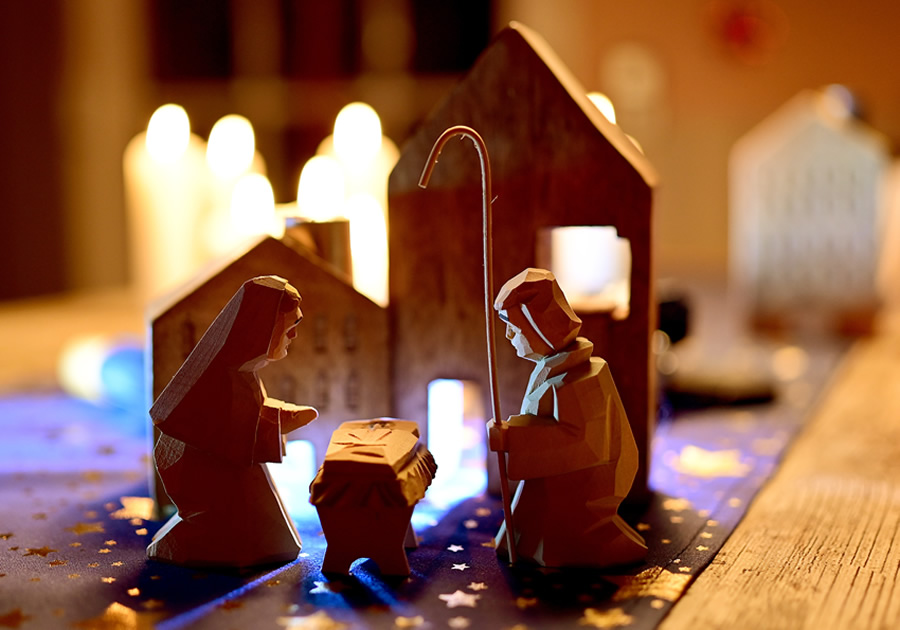
The Holy Family
12-26-2021Letter from the PastorDeacon Peter Auriemma, MDAs part of the beautification project of our Church, a large acrylic painting has been commissioned for the south wall. It will be a depiction of the Holy Family outside of their home in Nazareth.
To say that Nazareth was a humble, back-water place is an overstatement. It was a small hamlet of about 150 families and was founded by descendants of the royal family of King David. It is located in northern Galilee approximately 20 miles west of the Sea of Galilee.
We can appreciate a bit of Nazareth’s poor reputation by Nathanael’s comment when Philip tells him of Jesus’ hometown. Nathanael replies, “Can anything good come out of Nazareth?” (John 1:46). However, Nazareth was just a little over 3 miles from the large, bustling Greco-Roman city of Sepphoris, one of the capital cities of the Galilee district. According to some traditions, Sepphoris was the birthplace of Our Blessed Mother Mary. It is unknown when she and her family moved to Nazareth. At the time that the Holy Family lived in Nazareth, there was a massive building campaign going on in Sepphoris which required the work of numerous artisans. Many Biblical scholars believe that as a highly skilled craftsman, Joseph would have walked there seeking work. As Jesus grew, He would have accompanied him there also.
By trade, St. Joseph was a “tekton” in Greek. This is usually translated into English as a “carpenter”. However, for the people of his time, the term meant much more. A tekton was a very highly skilled craftsman who worked with any hard or lasting material. This could include stone and metal as well as wood. The tekton was trained from an early age by his father and his was considered a very noble and important profession in the life of the town where he lived and worked. He would make plows and all sorts of farming equipment, doors and wooden beams for roofs, and could craft fine furniture. He was also skilled in working in stone and was the one to choose and put in place the large stone boulders which were the foundations of all the homes in ancient Israel.
The Gospels tell us that St. Joseph was a descendant of King David and a member of the tribe of Judah, and these were prerequisites for the Messiah who was to come. He was also called a “righteous man”. This is a term of great respect given by his peers to a man recognized as one who always seeks the will of God and does it wholeheartedly. As a well-established tekton, he would have been considered a good find in the town of Nazareth, and he was eventually betrothed to Mary. They probably knew each other from childhood.
Mary was not only a member of David’s royal family, she was also a member of the priestly family of Aaron. She, therefore, would also have been considered a wonderful blessing for Joseph, and to the people of Nazareth, their marriage would have been seen as a very good match. We all know the story of what happened during the time of their betrothal, how Mary was found to be with child by the Holy Spirit.
We also learn that Joseph is told by an angel in a dream that he is to take Mary as his wife because the child is from God. Joseph is also being called to a special mission, just as Mary is. Joseph is to name the child Jesus. A man “naming” a child means that he claims the child as his own flesh and blood and takes full responsibility for him. That is why we should refer to Joseph as the adoptive father of Jesus.
We can never overstate the importance of the influence of St. Joseph in the life of Jesus. St. Joseph gives Jesus his legitimate standing in Israel, and Jesus’ lineage of the House of David and the tribe of Judah come from his ancestry as his legal father. St. Joseph would have taught Jesus his trade from a very early age. More importantly, St. Joseph’s influence on the intellectual and spiritual formation of his son cannot be over emphasized.
Jesus had to learn to be a man, a son of Israel – and this He learned from St. Joseph who was His spiritual mentor as well. It was the duty of a father to teach the daily prayers to his son and to pray them with him. It was also St. Joseph’s obligation to take Jesus to the synagogue every Sabbath and to prepare Him for His bar mitzvah – His coming of age – and to stand near Him as He read from the scroll of the Scriptures.
St. Joseph’s teaching about the Law and Judaism was so effective that Jesus is referred to as the “teacher” or “Rabbi” everywhere He goes. St. Joseph was the man that Jesus grew up calling “Abba”, which means daddy. We can see the great love that Jesus had for St. Joseph when He taught us to call our Father in Heaven Abba also.
Be sure to pause in front of our beautiful painting of the Holy Family in their home in Nazareth. And be sure to bring your problems and concerns to St. Joseph in prayer. He was the man closest to Jesus, and other than Our Blessed Mother Mary, no one knows the Heart of Jesus better than His earthly Abba, St. Joseph.
BACK TO LIST